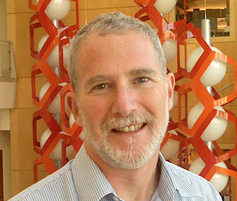 Tom Alber passed away in late March 2014 after a long and courageous fight with illness. Two people that worked closely with Tom at the ALS recall their memories of a dear friend and colleague. Information about his work can be found on the University of California, Berkeley web site.
Tom Alber passed away in late March 2014 after a long and courageous fight with illness. Two people that worked closely with Tom at the ALS recall their memories of a dear friend and colleague. Information about his work can be found on the University of California, Berkeley web site.
Howard Padmore
I met Tom early in 1998 at some social function to do with UCB-MCB. He struck me then as a person with a wonderfully tranquil exterior, but who underneath had a burning passion for life and for science. As he was a structural biologist who had the perennial problem of not having enough beam time, the conversation got around to how to build a low cost, simple beamline for protein crystallography and thus was born the idea for the UC Berkeley-UC San Francisco beamline. The whole thing moved from idea to a real project with amazing speed, powered by Tom’s vision and drive. He was like a whirlwind of energy. Originally the project was to be built on 9.1, a regular bend, but the superconducting bends were just around the corner and so he decided to take the risk and go with these new, much higher performance, sources. We had to “go for it.” He realized that there were significant risks; all the technology form end to end was new, but his attitude always was that to really achieve the best you had to stretch. We had to do something really new. UCSF joined the project, he got funds from NSF, funds from Sam Wheeler (a private donor), and we had fun and built it. Along the way I got to appreciate Tom as a good friend, a fellow cyclist, and as a person that was always kind and modest, brilliant, with a wonderful wry sense of humor. The USCF-UCB beamline is a monument to his work and I will remember him with fondness every time I walk by it. He will continue to inspire us all.
James Holton
Just before Tom “hooded” me at my Ph.D. graduation ceremony he professed that the only contribution he had made to my thesis was telling me it was impossible. He did a little more than that, but Tom’s genius was in his understanding of the whole picture. You don’t have to take credit to do great things, and people are most effectively motivated with little nudges, steering them in the right direction. Although I was his student, I never equaled his skill at that. At the time, I wasn’t sure why he invited me to join him at the design meetings for this new beamline that he and Howard were dreaming up, but I soon found myself acting as “translator” between the biologists and the engineering staff. He never once asked me to apply for the job to run the thing, but definitely put me in the position to see the role I could play. It has taken me years to appreciate just how much he did behind the scenes to make great science go forward, and it has been my honor to serve that vision. Tom always regarded his students as his colleagues, so I called him “boss” whenever I wanted to annoy him. We remained friends and colleagues long after he was my supervisor, and he even introduced me to my wife. I don’t think I ever have, or ever will again, owe so much to one person. And I will now forever be in his debt.